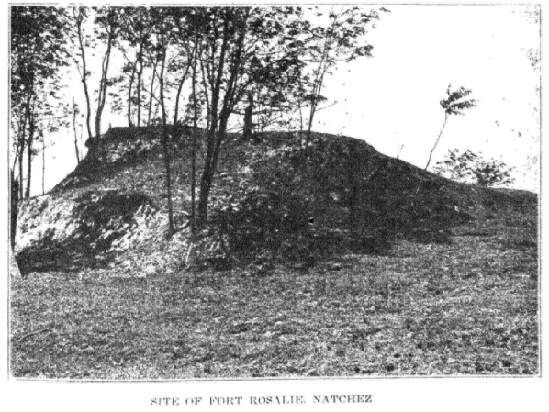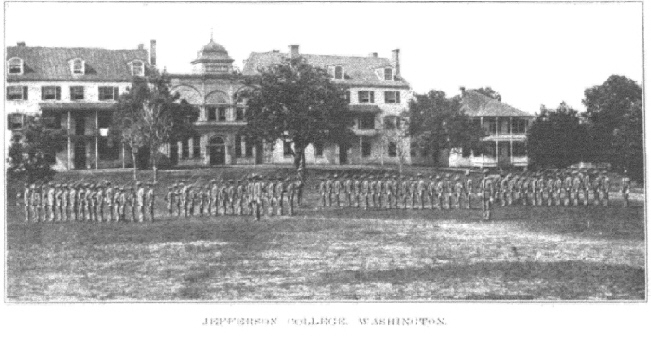.
Adams
County

ADAMS COUNTY
Chapter XLIV, pages 678-683
Adams is the oldest county in Mississippi
to retain its original name and the circumstances attending its creation
by Governor Winthrop Sargent, on April 2, 1799, have been fully described.
The southern part of Mississippi Territory was called Adams and the northern,
or upper division, the county of Pickering. But the name Pickering was
changed to Jefferson on January 11, 1802; thus giving Adams the advantage
in age. The southern division of the territory was named in honor of President
John Adams, then in office. The change in name from Pickering to Jefferson
was made in deference to the overwhelming political sentiment of the Territory
which was Republican, or Democratic as the party is now denominated. The
Jefferson Republicans of those days were numerous and strong.

Out of the great original area of Adams
County have been carved all the counties east and south of the present
county, and lying between its northern boundary line extended and the thirty-first
parallel of latitude. The present county of Adams contains an area of 426
square miles, and, with Wilkinson County formed the southern part of the
old Natchez District. This lofty bluff section of the State, overlooking
the Mississippi River, was a natural vantage ground for the earliest white
settlers. As early as 1700, the present site of Natchez was visited by
Iberville, Bienville, and de Tonti, in the interest of French colonization,
and in 1716, the French built Fort Rosalie, on the present site of Natchez.
The Natchez tribe of Indians, who originally occupied this region, were
finally expelled in 1729, and during most of the eighteenth century, the
whole Natchez District was disputed territory, being successively under
the control of the French, English and Spanish. With the evacuation of
the Spaniards in 1798, undisputed American control began. Many traces of
the divided allegiance owned by the early settlers of Adams County are
still evident in the original titles to the lands of the region, as well
as in the prevalence of names of French and Spanish origin. One of the
first white settlements made in the county was at Kingston, about sixteen
miles southeast of Natchez and about two miles from the Homochitto River.
In 1772, Samuel and Richard Swayze, of New Jersey, bought 19,000 acres
of land on the Homochitto of Capt. Amos Ogden, which had been granted to
him by the English Government in 1768. This land has since been known as
"Ogden’s Mandamus Grant," and in 1772, the Swayze brothers sailed to their
new home, with their families and kindred, in all about fifteen families.
They located their cabins close together about one mile from old Kingston.
In 1784 Caleb King built his home on the present site of Kingston and called
the place by that name. Dr. C.F. Farrar, of Kingston, Mississippi, a grandson
of Caleb King, has the original map of the place, with the names of the
streets, as drawn by the founder. The surrounding country became thickly
settled, and Kingston was once a small but prosperous pioneer town with
about 150 inhabitants. The first Protestant church in Mississippi is said
to have been erected at Kingston in 1798. >From about 1830 the place began
to decay, and many of the settlers moved away. It is now a deserted village.
Some of the descendants of the first settlers, who still inhabit the neighborhood,
are, the Swayzes, Foules, Ashfords, Byrds, Davises, Farrars, Vaughns, Thomases,
and Sojourners. The first charter of the city of Natchez, the seat of government
during the Spanish regime as well as the first Territorial capital, and
the present county seat of Adams County, was granted in 1784, and the first
mayor was Samuel Brooks. Stephen Minor was the original owner of much of
the present site of Natchez. Among its earliest settlers were Isaac Girault,
Christopher Miller, John Nugent and Jacob Eiler. The Natchez Gazette was
the first newspaper in Adams County as well as in the State. It was established
in 1799 by B.M. Stokes, and was later published by Andrew Marschalk for
nearly forty years under different names. Tradition says that the first
cotton-mill in the State, and perhaps in the world, was that of Sir William
Dunbar, erected at or near Natchez in 1834. Natchez is the oldest manufacturing
center in the State and one of the oldest in the South. As early as 1720,
it possessed a grist mill, a forge and a machine shop. The year 1812 gives
it seventeen manufacturing establishments and a population of 1,811. Its
first big enterprise was the Natchez Cotton Mill, 300 looms, followed by
the smaller Rosalie Mill. It has excellent shipping facilities provided
by the Mississippi River, and the Yazoo & Mississippi Valley Railroad.

That part of the town of Natchez known
as "Natchez Under the Hill," which was inhabited by the more disreputable
elements of the population, was completely destroyed by the great tornado
of May 7th, 1840, and much of the upper town was laid in ruins. Several
hundred people were known to have been killed, and three steamboats and
about eighty flatboats were sunk and their cargoes lost.
About two miles east of the city was located
"Concord," the famous old seat of the Spanish Governors. One of the historic
old towns of the county is Washington, now a small village but formerly
at intervals the Territorial and State capital, 1802-20; it was the seat
of Jefferson College, founded in 1803, the oldest endowed institution in
the Southwest, of Elizabeth Female Academy, the oldest chartered female
college in the country that conferred degrees. Adams County has been the
birthplace and the home of many of Mississippi’s most famous men of early
history and has perhaps the most colorful and romantic history of any county
of the State. When the State capital was removed to Jackson in 1822, the
City of Natchez and the entire county lost some of their prosperity. The
little town of Washington, so long the capital and literary center, declined
rapidly.

[JEFFERSON COLLEGE WASHINGTON]
Although Adams County has a number of
rural centers, it has no incorporated communities except Natchez, and from
the last census its population is given as follows: 1810, 1,511; 1820,
2,184; 1830, 2,789; 1840 (no returns); 1850, 18,601; 1860, 20,165; 1870,
19,084; 1880, 22,649; 1890, 26,031; 1900, 30,111; 1910, 25,265; 1920, 22,183.
As the 1920 census gave Natchez a population of 12,608, it is evident that
it is still the urban center of the county. This fact is even more evident
when it is noted that of the 1,300 wage earners employed in the industries
throughout the county nearly 1,200 are located in Natchez. The negroes
are still the farm laborers, as of the 1,673 agriculturists in the county,
the whites in that class are given as only 200. The value of all farm property
is given as $5,705,000, while the crops realized $1,062,000 in 1919, of
which the cereals brought in $307,000. Corn is the great cereal in Adams
County, the crop for 1920 being 165,000 bushels of the total cereal production
of nearly 167,000 bushels. Cotton is now classified as a "miscellaneous"
crop. Of the nearly 3,000,000 acres devoted to the raising of cotton in
Mississippi, Adams County allots less than 9,000 acres, from which are
produced less than 1,900 bales annually.
Adams County is a good live stock section,
its domestic animals being valued at $1,237,000; beef cattle lead the list,
with a value of $543,000, and horses, mules and swine follow in order.
Return to County History
Index
MSGenWeb Home
Source:
Mississippi The Heart of the South - By Dunbar Rowland, LL.D - Director
of the Mississippi State Department of Archives and History. Vol.
II Illustrated. Chicago-Jackson; The S. J. Clarke Publishing
Company, 1925. Public Domain
Copyright Notice: All files
and photographs on this site are copyrighted by their creator and/or contributor,
unless otherwise noted. They may be linked to but may not be reproduced
on another site without specific permission from The MSGenWeb State Coordinator
or the Assistant State Coordinator, and/or their contributor. Although
public information is not in and of itself copyrightable, the format in
which they are presented, the notes and comments, etc., are. It is however,
quite permissible to print or save the files to a personal computer for
personal use ONLY.
  
|







